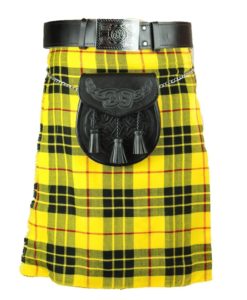DETAILED FACTS ABOUT THE AUTHENTIC UTILITY KILT
The History Of The Utility Kilt
Until The End Of The 16th Century, Scots Wore Kilts, Which
Are Still Worn Today. The Contemporary Utility Kilt Is Said To Have Descended
From The Belted Plaid Or Great Kilt, A Full-Length Garment Whose Upper Half
Could Be Worn As A Cloak Draped Over The Shoulder Or Brought Up Over The Head
As A Hood. The "Modern" Military Utility Kilt," Which Is Only
The Bottom Half Of The Huge Utility Kilt, Did Not Develop Until The Late 17th
Or Early 18th Century. It Is Akin To The "Small Kilt." 'Kilt,' A Utility Term Meaning To Tuck One's Garments In, Is The Source Of The Term
"Utility Kilt."
Fabrics Used In Making A Utility Kilt
The Typical Utility Kilt Is Made Of Twilled Wool And Is Used
In Today's Highland Games Tournaments. Each Weft Thread Crosses Over And
Beneath Two Warp Threads Simultaneously In The "2-2 Variety" Of Twill
Weave Used In Utility Kilts. That's Why The Fabric Gets Its Distinctive
"Twill" Line Weave Pattern. It Is Referred To As Tartan When It Is
Made With A Certain Sett Or Written Color Pattern. The Utility Kilts Used By
Irish Pipers, On The Other Hand, Are Made Of A Single Color Of Cloth, Most
Commonly Saffron Or Green kilts shop.
Authentic Utility Kilt Characteristics
One Of The Most Distinguishing Features Of A Utility Kilt Is
Its Tartan Pattern Or Sett. Certain Patterns Have Been Linked To Certain
Families And Clans For The First Time In The Last Century Or Two. It Wasn't
Until The Victorian Era That The System Of Tartan Names Began To Be
Meticulously Documented And Developed, Mostly For Economic Objectives.
Historically, Rather Than Being Identified With Individual Clans, Highland
Tartans Have Been Linked To Geographical Locations. Tartans Are Now Available
For Districts, Counties, Organizations, And Businesses. Among Other Things,
There Are Sets For Various Countries, Universities, And Institutions As Well As
Sports Teams, Individuals, As Well As Commemorative And Simple Generic Patterns
That May Be Worn By Everyone.
Utility Kilt Measurements
An Individual Wearer's Dimensions Are Taken Into Consideration While Making A Kilt Tailored To Their Specific Needs. Kilt Length, Hips, And At Least Three Other Measurements Are Frequently Required. The Rise (The Distance Above The Waist) Or The Fall (The Distance Below The Waist) May Also Be Taken Into Consideration (The Distance From The Waist To The Broadest Point Of The Hips). Utility Kilt That Is Properly Made Are Neither Too Loose Nor Too Tight, So That The Wearer May Easily Wrap The Kilt Around Their Body Without Creating "Scalloping." The Length Of The Utility Kilt, When Secured At The Waist, Stops No Lower Than Halfway Over The Kneecap And No Higher Than An Inch Above It.
Sewing And Pleating Of The Utility Kilt
Pleats Can Be Arranged In Relation To A Pattern In Two Ways. This Plaid's Horizontal Stripes Are Picked Out And Folded In Such A Way As To Run Down The Center Of Each Pleat When It Is Pleated. Because Of This, The Design Of The Pleated Area Of The Kilt (The Back And Sides) Appears Different From The Unpleasing Front, Typically Emphasizing The Horizontal Bands Rather Than Establishing A Balance Between Them. The Term "Military Pleating" Refers To The Practice's Widespread Use By The Military. It Is Widely Used By Pipe Bands As Well. Each Pleat's Depth And Breadth Are Its Two Distinguishing Features. The Region That Protrudes From Under The Pleat Above It Determines The Breadth Of The Pleat. A Normal Utility Kilt's Pleated Width Ranges From Around 1/2" To About 3/4" Depending On The Size Of The Sett And The Amount Of Material Employed.
Reference
https://menkiltsshop.blogspot.com/2022/07/detailed-facts-about-authentic-utility.html





Comments
Post a Comment